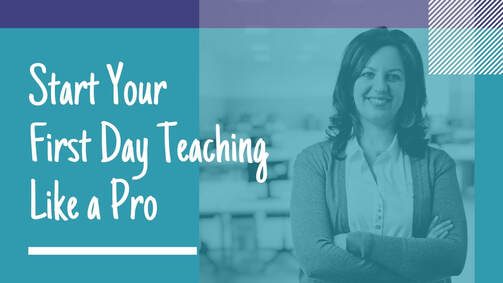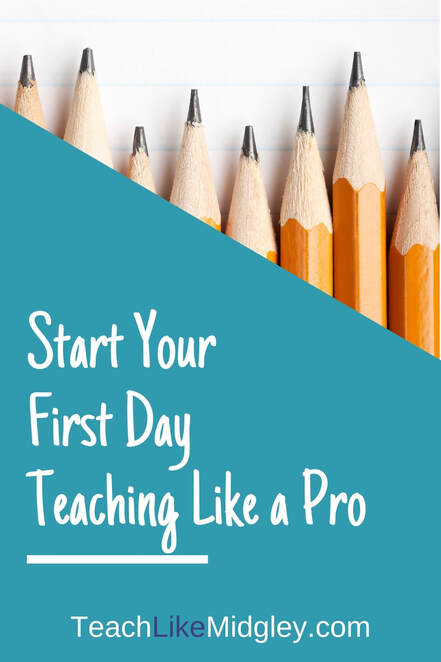Start Your First Day Teaching Like a Pro
Nerves. Excitement. Hopes. Anticipation for what’s to come…
Those are the feelings I get when the 1st day of school springs upon us. No matter how many years I’ve been teaching. I remember those feelings were only magnified my first year as a teacher.
You never know how the 1st day of school is going to go… And neither do your students. They are counting on YOU to make things run smoothly.
Which means you need to be prepared. Be prepared for as much as possible.
Build in time for you to handle all the little things that come up. Because trust me, they will come up.
Those are the feelings I get when the 1st day of school springs upon us. No matter how many years I’ve been teaching. I remember those feelings were only magnified my first year as a teacher.
You never know how the 1st day of school is going to go… And neither do your students. They are counting on YOU to make things run smoothly.
Which means you need to be prepared. Be prepared for as much as possible.
Build in time for you to handle all the little things that come up. Because trust me, they will come up.
It’s also your opportunity to set the standard for what you expect to take place in your classroom. First impressions can be powerful. How you start your day, how you start your class, sets the tone for your students.
Your teaching begins as your students approach your classroom doorway. How do you expect students to enter your classroom? This training is immediately underway.
This post will share with you the tried and true, proven strategies I use to start my first day.
Before Students Arrive...
There are two essentials for that first day – assigned seats and a task to complete.
I like to use a student survey as the task. I also use the survey to dictate assigned seating.
First write student names at the top of each survey using bold letters, usually with a flair pen. To be sure they are big and easy to read, I generally only write the first name with the first initial of the last name.
Then I place the surveys on the student desks – in the appropriate assigned seating locations.
On the whiteboard, my directions state:
Please find the paper with YOUR name at the top. Sit at that desk. Place your belongings under your desk and quietly begin working.
I like to use a student survey as the task. I also use the survey to dictate assigned seating.
First write student names at the top of each survey using bold letters, usually with a flair pen. To be sure they are big and easy to read, I generally only write the first name with the first initial of the last name.
Then I place the surveys on the student desks – in the appropriate assigned seating locations.
On the whiteboard, my directions state:
Please find the paper with YOUR name at the top. Sit at that desk. Place your belongings under your desk and quietly begin working.
When Students Arrive...
I wait at the door to greet the students. When I shake their hand, I ask them to enter quietly, find the paper with their name, sit down and begin working.
The survey is front and back and some questions require sentence answers. It asks about hobbies, strengths, about homework and study habits.
While students are quietly working, I am able to greet all students individually as they enter and give help to any student who may need it – which could be a locker issue, schedule issue, or maybe they just need directions.
If a student cannot find their survey, it is a quick indicator to me that they are probably in the wrong place.
Any empty seats are also a quick indicator of who is missing.
By the time I am ready to get started, we are roughly 10 minutes into the start of class and a small handful of students have finished. I do not collect them. I assign the survey as homework, and ask them to bring it back complete the next day. What’s even more fun, is giving them a homework assignment for their parents! Most students get a kick out of this – and are eager to take the Parent Survey home.
The survey is front and back and some questions require sentence answers. It asks about hobbies, strengths, about homework and study habits.
While students are quietly working, I am able to greet all students individually as they enter and give help to any student who may need it – which could be a locker issue, schedule issue, or maybe they just need directions.
If a student cannot find their survey, it is a quick indicator to me that they are probably in the wrong place.
Any empty seats are also a quick indicator of who is missing.
By the time I am ready to get started, we are roughly 10 minutes into the start of class and a small handful of students have finished. I do not collect them. I assign the survey as homework, and ask them to bring it back complete the next day. What’s even more fun, is giving them a homework assignment for their parents! Most students get a kick out of this – and are eager to take the Parent Survey home.
You can get both my Student Survey and Parent Survey - HERE
This is my first opportunity to set the expectation that I do not collect work early, so there is no reason to rush through the work.
At that point, I start working down my list. 1st day lesson plans don’t really exist… Of the 6 principals I’ve worked for, none of them have required lesson plans for the first day.
The reality is, 1st day lesson plans are really more of a checklist. Often times, this checklist includes items that have been dictated by the administration.
Be sure to include opportunity part way through to have students move and engage. It can be easy find yourself talking extensively, and you’ll find it’s not beneficial to students. A room tour is always an easy way to get students moving.
At that point, I start working down my list. 1st day lesson plans don’t really exist… Of the 6 principals I’ve worked for, none of them have required lesson plans for the first day.
The reality is, 1st day lesson plans are really more of a checklist. Often times, this checklist includes items that have been dictated by the administration.
Be sure to include opportunity part way through to have students move and engage. It can be easy find yourself talking extensively, and you’ll find it’s not beneficial to students. A room tour is always an easy way to get students moving.
Final Thoughts...
It’s always best to ease in your students. Especially if you are teaching at the secondary level, remember that your students are interacting with multiple teachers. Talk about overwhelm.
I try to leave my syllabus for at least the second day. If you are looking for more details about how I get my 6th grade social studies class underway at the start of the year, then be sure you checkout this resource: First 7 Days of School for Teaching Ancient Civilizations Oh, and by the way, my survey pack is included with this resource! But you can check it out individually, here: Back to School: Parent and Student Survey Pack
I try to leave my syllabus for at least the second day. If you are looking for more details about how I get my 6th grade social studies class underway at the start of the year, then be sure you checkout this resource: First 7 Days of School for Teaching Ancient Civilizations Oh, and by the way, my survey pack is included with this resource! But you can check it out individually, here: Back to School: Parent and Student Survey Pack
You Might Also Like...
Let's Connect...

Welcome! I'm Hillary Midgley, a veteran 6th grade teacher.
I create educational materials and develop curriculum for other teachers. I specialize in teaching students how to learn through my Study Skills Curriculum. I have established fundamental classroom systems and structures for teachers to help them streamline their classroom. And my passion is teaching ancient history through engaging activities with foundations in academic skills. Here you will find resources on all of these topics and more. Learn more about me here.
Want more great teaching tips, organization and management ideas?
Visit us on Facebook, Instagram and Pinterest!
Visit us on Facebook, Instagram and Pinterest!
|






